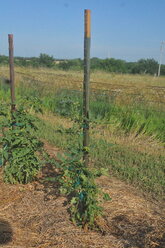 Tomatoes perform best with regulated soil moisture. Mulch provides many benefits in the garden including maintaining moisture levels, suppressing weeds and moderating soil temperatures. Exposed soil may develop a crust on the surface from repeated wet then dry conditions. A crusty soil surface restricts air flow and inhibits water absorption. A layer of mulch can prevent the soil from crusting over. Straw mulch is a popular choice for tomatoes. Avoid using hay as it introduces weed seeds. A thin layer (2-3 inches) of dry, herbicide-free, grass clippings can be used. If the lawn was treated with quinclorac (Drive), the clippings should not be used as mulch. (Cynthia Domenghini) 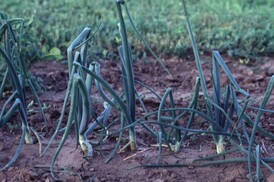 As onion bulbs develop, they will emerge from the soil. Do not mound the soil up over the bulbs. A nitrogen fertilizer can help plants develop healthy top growth which directly affects the bulb growth. Ammonium sulfate (21-0-0) at a rate of ½ cup per 10 feet of row can be applied. Other fertilizers high in nitrogen such as, 29-5-5 or 27-3-3, can be used at a rate of 1/3 cup per 10 feet of row. Water the fertilizer into the soil two to three inches from the plants. When the bulbs break through the soil, stop fertilizing. Regular weeding is necessary to protect onions from competition over nutrients and space to expand. Gently cultivate the rows to avoid damaging onions. Onion bulb size will vary depending on the amount of water the plants receive. Ensure plants are receiving regular water during dry weather. (Cynthia Domenghini) 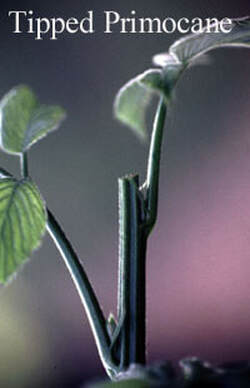 Blackberries and Raspberries have the same growth and fruiting habits. The perennial root system survives many years while the top growth, canes, are biennial, living only two years. Primocanes are the first-year’s canes. They are typically green and for most varieties, do not set fruit. The second year these canes have a thin, brown bark and are called “floricanes”. Floricanes fruit and then die. Each year new primocanes develop so the berry plant has both primocanes and floricanes present after being established. Tipping, or pinching off the top two to three inches of primocanes encourages branching (lateral growth) and can increase fruiting yields by three to five times the following year. Everbearing berry plants do produce fruit on the primocanes and should be pruned differently than the traditional plants that do not fruit on the first year’s growth. Blackberries: Traditional – Tip at 4 feet Blackberries (everbearing) – Tip at 25 to 30 inches high. Laterals are also tipped when they reach 25 to 30 inches Black Raspberries – Tip at 3 feet Purple Raspberries – Tip at 36 to 40 inches Red Raspberries – Do not tip (Cynthia Domenghini) 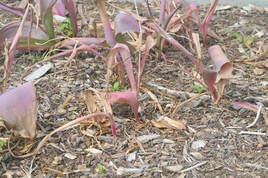 Spring-flowering bulb foliage should be left intact so they can generate and direct energy into the bulb to promote flowering the next year. When the foliage turns brown and wilts, it has “ripened” and can be removed. At this time of year, tulips, daffodils and many other spring-flowering bulbs have ripened. Foliage can be removed with clippers or even a mower. Keep records of where the various bulbs are planted because once the foliage is removed the bulbs will be hidden below the soil. (Cynthia Domenghini) 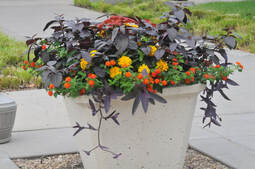 I have had several questions this spring on potting soils and how to choose the best potting media. Dr. Cheryl Boyer, our Nursery Crop and Marketing Specialist, has done extensive studies on potting soils and has written the following to help homeowners make a good choice. We will present her material is three parts or steps with one step each week. Step 1: What are You Using it For? Step 2: Understanding Major, Minor, and Specialty Components Step 3: Mixing and Managing Last week we covered Step 1. So, here is Step 2. (Ward Upham) Step 2: Understanding Major, Minor, and Specialty Components These materials are regionally sourced and often composted to reduce particle size. Some materials are manufactured for the purpose of being used in potting media and many more are by-products of other industries. They are all fine as components but look at the label to understand how much of each “ingredient” is mixed, by volume, into the product you’re purchasing. If that information isn’t on the bag, be wary of purchasing. · Major components: Bark (or “composted forest products”), peat (this might be defined by type of peat which often refers to the source material or the coarseness), soil (don’t pay for this unless it’s local/regional and advertised as a single-component soil amendment—not as a potting media), manure, sand. Other waste-product alternative materials such as coconut coir and wood fiber are also great to use, but they’re not seen as often in consumer-level products. · Minor components: Perlite (little white pellets--it’s for aeration, not fertilization), vermiculite (shiny heat-expanded rock pieces), rice hulls (also for aeration with an added bonus of weed control when applied to the tops of containers). These are the most common. · Specialty components: mycorrhizae (symbiotic fungal organism that, mixed in, can be very beneficial in a container system by expanding the root capacity to take up nutrients and water, it’s less effective in field soil where these organisms are already abundant), fungicide (some products are designed to address specific fungal growth issues). A note about manure and compost: These are good organic materials; however, you must be careful that the source can guarantee the material that produced the manure (hay, pasture grass, etc.) was not treated with herbicide. Many herbicides used in pasture management have a very long half-life and can persist in your landscape beds, killing desired plants. A note about organic products: While most media components are considered “natural” and are likely produced using organic practices, few will be labeled as organic simply due to the nature of the organic certification process. An organically labeled product is not inherently better than another, though if you’re looking for a bagged manure product, organic will ensure the absence of herbicide residue. (Cheryl Boyer) 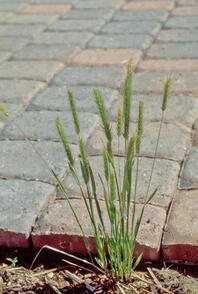 Little barley (Hordeum pusillum) is a winter annual bunch grass with seedheads that resemble little foxtails. There is often confusion between the two due to the similarities in appearance. Little barley appears in early fall and survives throughout the cooler months. Seedheads develop and mature in the spring through mid-summer. Foxtails are a summer annual and seedheads don’t begin to develop until mid to late summer. Little barley is commonly found in disturbed areas such as roadsides, overgrazed pastures and sparse lawns. The best control against this weed is maintaining a thick lawn and mowing it high so the sunlight doesn’t reach the soil. For sparse lawns, overseeding in late August to early September can help, but little barley that germinates early may still appear. A preemergent herbicide can be used to prevent the little barley from sprouting if you do not plan to overseed. Dimension (dithiopyr), is labeled for barley (Herodium spp.) which includes little barley. Apply the preemergent herbicide in mid-September and water in to activate. In southern Kansas you may have to apply a couple weeks earlier. (Cynthia Domenghini) 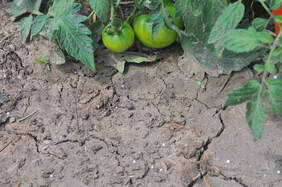 Sidedressing, or topdressing, is a fertilizing practice done during the growing season to provide supplemental nutrition as plants mature. Following proper application protocols protects the plants from damage while promoting vegetable, fruit and flower production. This chart, created by Gregg Eyestone, Horticulture Agent from Riley County, offers information pertaining to sidedressing nitrogen on annual flowers, some perennial flowers, vegetables and small fruit. (Cynthia Domenghini) 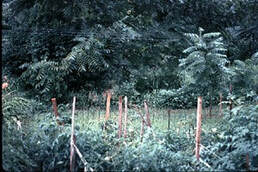 Juglone is a chemical produced in the leaves, fruit hulls and inner bark of trees in the walnut family (Juglandaceae) including: black walnut (highest producer), Persian walnut, butternut and pecan. With rain, the chemical is leached into the soil. The fungicidal and insecticidal properties of juglone make it toxic to many plants causing wilting and stunting. Plants grown closer to these allelopathic trees may show worse symptoms as they come in contact with the tree roots. Susceptible plants, such as tomatoes, grown next to a walnut tree may wilt and die prematurely whereas those grown further away may have stunted growth, but survive. Even if the affected plants do produce fruit, it may have a less desirable, nutty taste. Symptoms of walnut wilt may resemble those of fusarium and verticillium wilt including wilting and yellowing leaves that eventually drop. Stem tissue may also turn brown. The diseases can be distinguished by the presence of trees from the walnut family. Tree removal does not provide an immediate control as the toxicity can remain in the soil and debris for multiple years. Avoid growing the following susceptible plants near Juglandaceaes: tomato, potato, blackberry, apple, lilac, asparagus, chrysanthemum, peony along with many other herbaceous and woody plants. Some walnut wilt resistant plants include, but are not limited to: black raspberry, corn, bean, carrot, dandelion and zinnia. (Cynthia Domenghini) |
AuthorsCynthia Domenghini runs the Horticulture Response Center in the Department of Horticulture and Natural Resources at Kansas State University. Other contributors include K-State Extension Specialists. Archives
March 2024
Categories
All
|
| K-State Research and Extension Horticulture Newsletter |
|
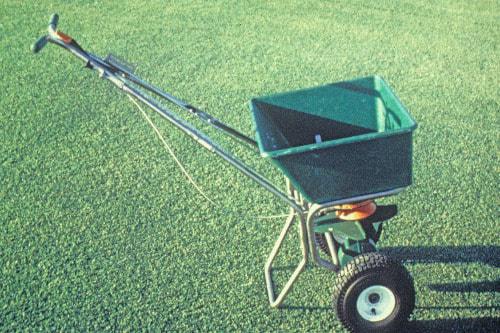
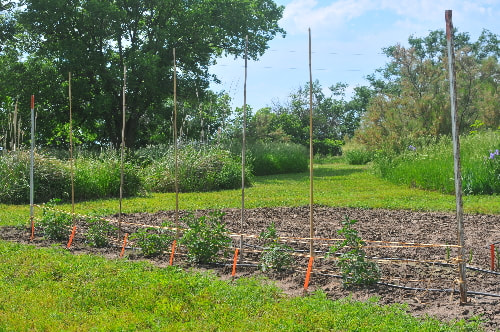
 RSS Feed
RSS Feed
